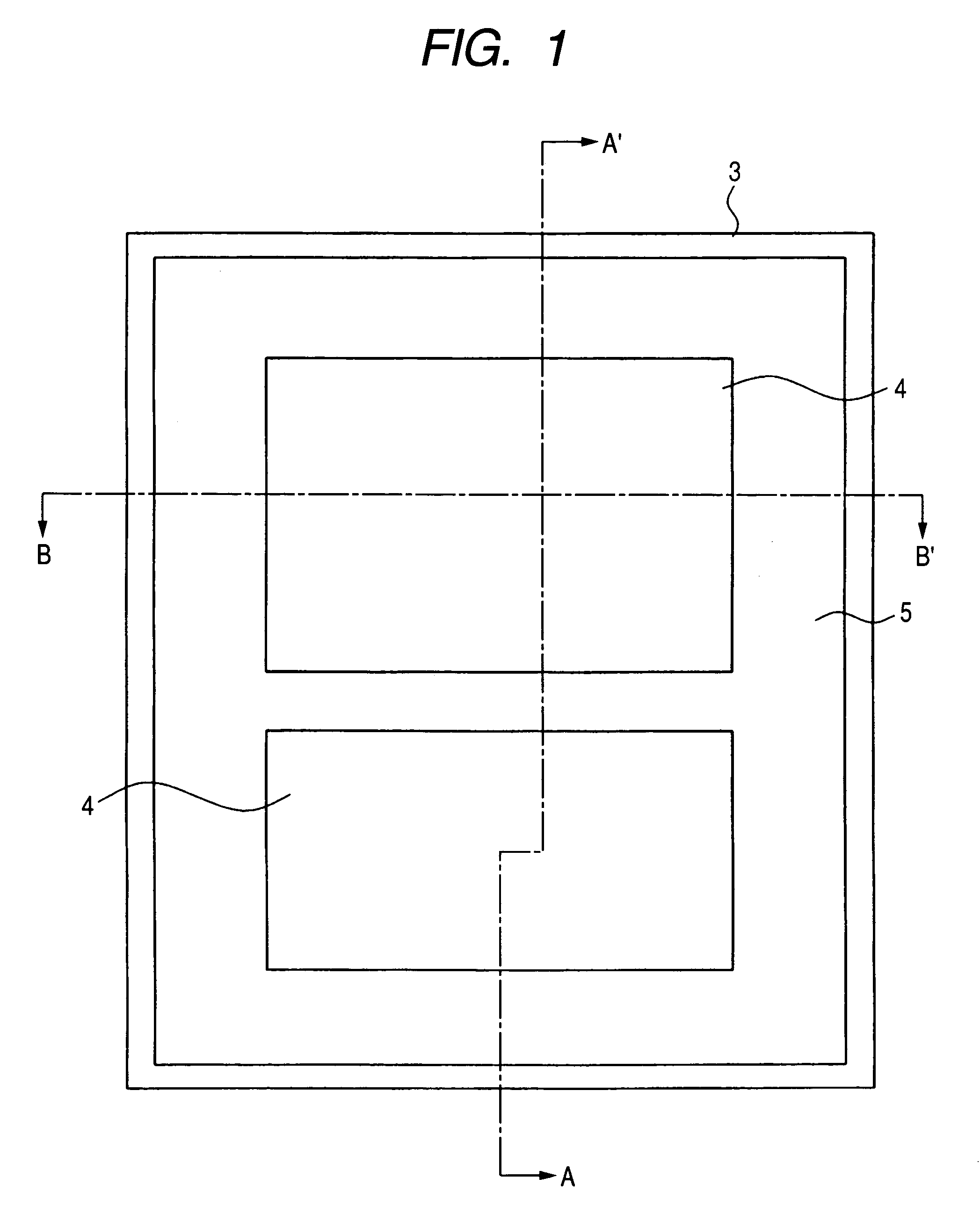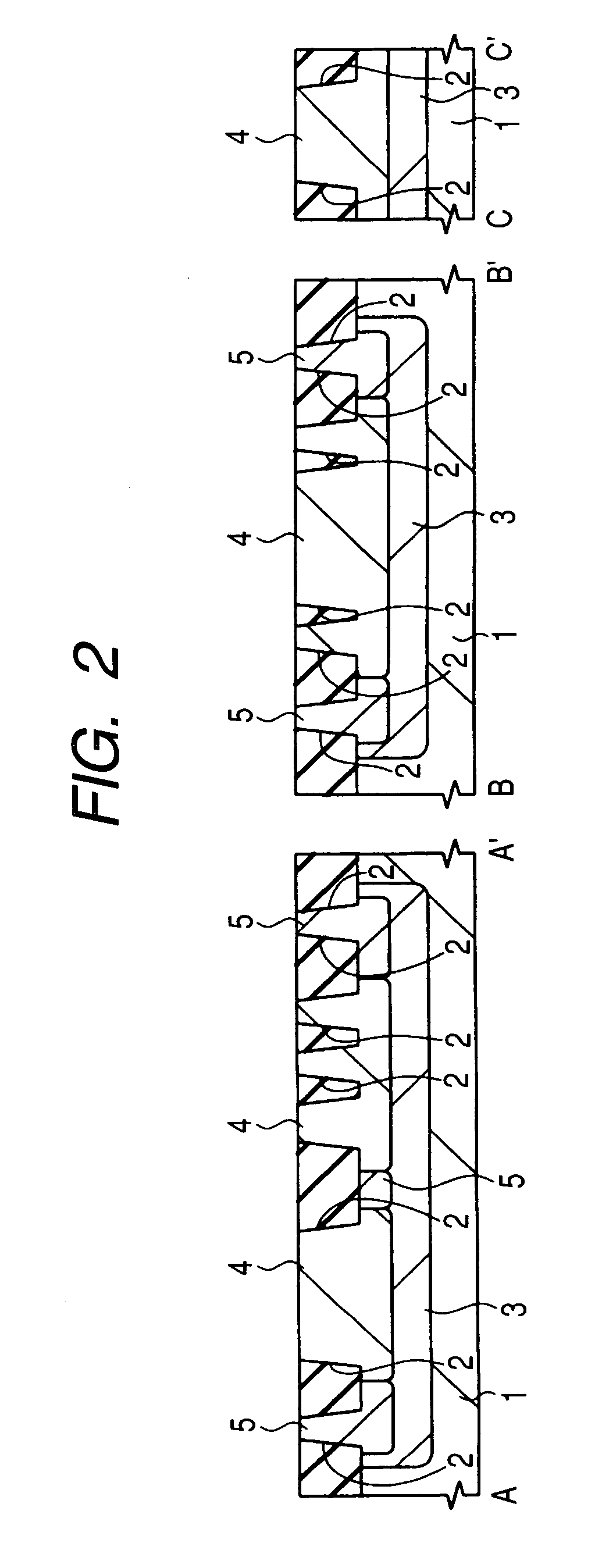Semiconductor device
a technology of semiconductor devices and semiconductors, applied in semiconductor devices, digital storage, instruments, etc., can solve the problems of increasing the manufacturing cost of the module, and accelerate the deterioration of the element, so as to achieve good data retaining properties and less element deterioration
- Summary
- Abstract
- Description
- Claims
- Application Information
AI Technical Summary
Benefits of technology
Problems solved by technology
Method used
Image
Examples
embodiment 1
(Embodiment 1)
[0050]The semiconductor device according to Embodiment 1 has a nonvolatile memory. The manufacturing steps of the semiconductor device of Embodiment 1 will next be described with reference to FIGS. 1 to 13.
[0051]FIGS. 1, 3, 6 and 11 are each a fragmentary plan view of a memory cell region of the semiconductor device of Embodiment 1 during its manufacturing step, while FIGS. 2, 4, 5, 7–10, 12 and 13 are each a fragmentary cross-sectional view illustrating the manufacturing step of the semiconductor device of Embodiment 1. In each cross-sectional view, a portion marked with A and A′ is a cross-section taken along a line A–A′ in the corresponding plan view; a portion marked with B and B′ is a cross-section taken along a line B–B′ in the corresponding plan view, and a portion marked with C and C′ is a cross-section of a part (a region in which an n channel type MISFET (Metal Insulator Semiconductor Field Effect Transistor) is to be formed) of a peripheral circuit region. E...
embodiment 2
(Embodiment 2)
[0080]Writing, erasing and reading operations in a nonvolatile memory according to Embodiment 2 will next be described with reference to FIG. 18.
[0081]FIG. 18 illustrates a cross-section taken along a line D–D′ of FIG. 14 in Embodiment 1. As illustrated in FIG. 18, the nonvolatile memory of Embodiment 2 has almost a similar structure to that of the nonvolatile memory according to Embodiment 1.
[0082]The writing and reading operations of data in the nonvolatile memory of Embodiment 2 are similar to those of the nonvolatile memory of Embodiment 1. As illustrated in FIG. 18, erasing of data is carried out by applying 9V to the n well 5 (n type semiconductor isolation region 3), 0V is applied to the p type semiconductor regions 15B (the p wells 4 having MISFETs Qw1, Qw2, Qr1, Qr2 formed thereover), −9V to the p type semiconductor regions 15A (the p wells 4 having the capacitive elements C1, C2 formed thereover), and 7V to the drain (n type semiconductor region 14B) of the d...
embodiment 3
(Embodiment 3)
[0085]Data writing, erasing and reading operations in a nonvolatile memory according to Embodiment 3 will next be described with reference to FIG. 19.
[0086]FIG. 19 illustrates the cross-section taken along a line D–D′ of FIG. 14 in Embodiment 1. As illustrated in FIG. 19, the nonvolatile memory of Embodiment 3 has almost a similar structure to that of the nonvolatile memory of Embodiment 1.
[0087]The data erasing and reading operations in the nonvolatile memory of Embodiment 3 are similar to those of the nonvolatile memory of Embodiment 1. As illustrated in FIG. 19, writing of data is carried out by applying 9V to the n well 5 (n type semiconductor isolation region 3), −9V to the p type semiconductor regions 15B (the p wells 4 having the MISFETs Qw1, Qw2, Qr1, Qr2 formed thereover), and 9V to the p type semiconductor regions 15A (the p wells 4 having the capacitive elements C1, C2 formed thereover), and setting the source and drain (n type semiconductor regions 14B) of ...
PUM
 Login to View More
Login to View More Abstract
Description
Claims
Application Information
 Login to View More
Login to View More - R&D
- Intellectual Property
- Life Sciences
- Materials
- Tech Scout
- Unparalleled Data Quality
- Higher Quality Content
- 60% Fewer Hallucinations
Browse by: Latest US Patents, China's latest patents, Technical Efficacy Thesaurus, Application Domain, Technology Topic, Popular Technical Reports.
© 2025 PatSnap. All rights reserved.Legal|Privacy policy|Modern Slavery Act Transparency Statement|Sitemap|About US| Contact US: help@patsnap.com



